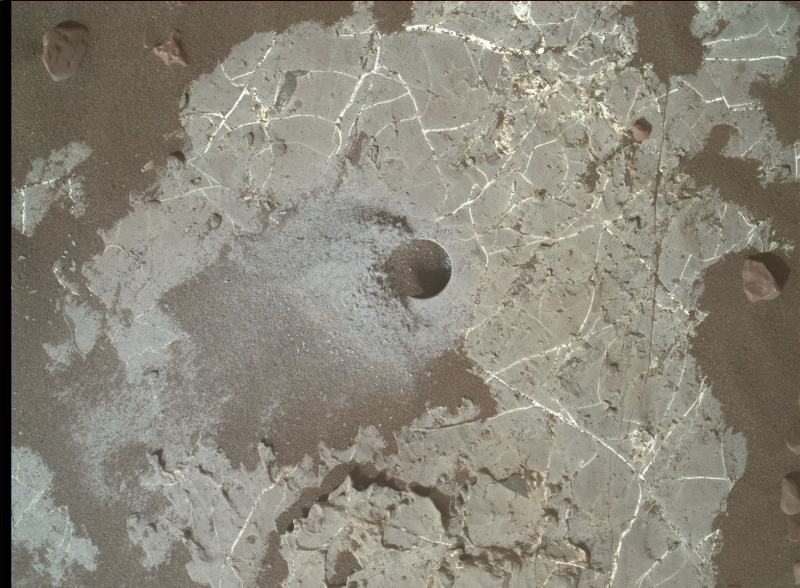
All life on Earth consists of carbon. On our planet, carbon exists in rocks, ocean, the air and all living things. Scientists announced on January 17, 2022, that they’ve discovered enriched amounts of carbon-12, life’s most crucial isotope, in powdered rock that Curiosity drilled from a hole on Mars. While carbon-12 on Earth is a sign of life, it’s too soon to say whether this discovery on Mars is a sign of life there as well. But life is one of the three possibilities that scientists are entertaining to explain the newly discovered carbon-12 on Mars.
The journal Proceedings of the National Academy of Sciences published the scientists’ peer-reviewed study in its January 25, 2022, issue.
The discovery of carbon isotopes on Mars
The Curiosity rover has been exploring the Gale crater on Mars since 2012. Curiosity drilled into the sandstone floor of the crater, retrieving a sample of rock ground into a fine powder. The rover has a science lab on board and is able to provide sample analysis from the surface of Mars. It heated the powdered rock to release the gas inside.
The researchers were surprised to find enriched amounts of the isotope carbon-12 in these samples and depleted amounts of carbon-13. Samples from the red planet’s atmosphere and from Martian meteorites that have struck Earth do not have these same amounts of carbon. The scientists think this may be because the new samples are from well-preserved, ancient surfaces on the crater floor.
The 2022 lunar calendars are here. Order yours before they’re gone!

Why are carbon-12 and carbon-13 significant?
Carbon-12 and carbon-13 are two stable isotopes of carbon. Lead author Christopher House of Penn State said:
The amounts of carbon-12 and carbon-13 in our solar system are the amounts that existed at the formation of the solar system. Both exist in everything, but because carbon-12 reacts more quickly than carbon-13, looking at the relative amounts of each [isotope] in samples can reveal the carbon cycle.
The carbon cycle is how carbon atoms travel from the atmosphere to life forms to rocks and soil and back again.
On Mars, the new study shows the samples had enriched carbon-12 and depleted carbon-13. House explained:
The samples [that are] extremely depleted in carbon-13 are a little like samples from Australia taken from sediment that was 2.7 billion years old. Those samples were caused by biological activity when methane was consumed by ancient microbial mats, but we can’t necessarily say that [is the case] on Mars because it’s a planet that may have formed out of different materials and processes than Earth.
The samples enriched with carbon-12 are a tantalizing find, because living creatures on Earth use carbon-12 to metabolize food and for photosynthesis. Finding more carbon-12 in ancient rocks suggests signatures of life-related chemistry.

Three possible sources
So how do scientists account for the amounts of carbon in the samples? The researchers have three possible scenarios: cosmic dust, ultraviolet degradation of carbon dioxide, or ultraviolet degradation of biologically produced methane.
The cosmic dust argument is plausible, though evidence for it is lacking. Every 100 million years or so, our solar system passes through a molecular cloud that can deposit dust on the planets. But then it should be found on Earth as well, and Earth has hardly any evidence of this dust. Glaciers are also required for that argument to work on Mars, and so far there is limited evidence of past glaciers in the Gale crater.
The theory of ultraviolet degradation of carbon dioxide is one that some papers have predicted, but the scientists lack enough evidence to rule this one in or out.
Lastly, we have the biological explanation. Depleted samples of carbon-13 on Earth are a signal of ancient bacteria that consumed microbially produced methane. Ultraviolet light would then convert the methane in the atmosphere into more complex molecules. These would follow the carbon cycle and return to the rocks where they were found. But, as of now, there has been no discovery of bacteria or microbes on the surface of Mars.
House said:
All three possibilities point to an unusual carbon cycle unlike anything on Earth today. But we need more data to figure out which of these is the correct explanation.
Comparing Mars and Earth
Scientists have to both compare what they’ve learned from Earth to what’s happening on Mars, while also taking into consideration that what happens on another planet could have completely different causes. House said:
On Earth, processes that would produce the carbon signal we’re detecting on Mars are biological. We have to understand whether the same explanation works for Mars, or if there are other explanations, because Mars is very different.
Jennifer Eigenbrode, a Goddard astrobiologist and author of the study, said they made a point to examine all the possibilities:
The hardest thing is letting go of Earth and letting go of that bias that we have and really trying to get into the fundamentals of the chemistry, physics and environmental processes on Mars. We need to open our minds and think outside the box, and that’s what this paper does.
Another author, Andrew Steele of the Carnegie Institution for Science, explained how the proliferation of life on Earth makes comparing the carbon cycle on the two planets challenging:
There’s a huge chunk of the carbon cycle on Earth that involves life, and because of life, there is a chunk of the carbon cycle on Earth we can’t understand, because everywhere we look there is life.
Steele went on to say:
Defining the carbon cycle on Mars is absolutely key to trying to understand how life could fit into that cycle. We have done that really successfully on Earth, but we are just beginning to define that cycle for Mars.
Bottom line: Scientists have discovered rock samples from Mars that are enriched in carbon-12, an isotope that is crucial to life on Earth.
Source: Depleted carbon isotope compositions observed at Gale crater, Mars











